
Difference between mechanical ventilation and oxygen therapy
Oxygen therapy (also called ‘oxygen supplementation therapy’) in medicine refers to the administration of oxygen to the patient for therapeutic purposes, as part of a therapy implemented in cases of both chronic and acute respiratory failure
Oxygen therapy and mechanical ventilation, the modes of oxygen administration are different and include:
- face masks: they cover the nose and mouth; they are attached behind the ears by means of an elastic band and receive oxygen from a small tube hooked into a special area at the front of the mask, which connects the mask to the oxygen reservoir or a self-expanding balloon (AMBU)
- nasal cannula (goggles): excellent for home oxygen therapy at low flows, it consists of two small tubes to be inserted into the nose and which are attached by passing them behind the ears and under the chin, where they are connected to a cannula which is in turn connected to the oxygen source;
- O2 probe or nasal probe: this works in a similar way to the nasal cannula, but with a single tube that must, however, reach deep into the nasopharynx;
- transtracheal oxygen therapy: requires tracheotomy, i.e. the surgical incision of the neck and trachea, so that a small tube can be inserted directly into the trachea, so that oxygen can reach it; only used in hospitals, it is necessary due to the presence of an obstruction to the passage of air
- incubator/oxygen tent: both provide an oxygen-rich internal environment and are very useful when the patient is an infant;
- hyperbaric chamber: this is a closed space inside which it is possible to breathe 100% pure oxygen, at a higher than normal pressure; useful in cases of gas embolism, e.g. from decompression syndrome;
- mechanical ventilator with continuous positive pressure: allows ‘mechanical ventilation’ (also called ‘artificial ventilation’), i.e. breathing support for patients who are partially or totally unable to breathe spontaneously. The mechanical ventilator works by ‘mimicking’ the action of the respiratory muscles that enable breathing acts; it is a life-saving device widely used in intensive care units for patients in critical condition.
- Mechanical ventilation (also called artificial or assisted ventilation) refers to breathing support for people who are partially or totally unable to breathe spontaneously; mechanical ventilation supplements or completely replaces the activity of the inspiratory muscles by providing the energy needed to ensure an adequate volume of gas to the lungs.
Mechanical ventilation is therefore a system through which oxygen therapy can be carried out.
Read Also:
Emergency Live Even More…Live: Download The New Free App Of Your Newspaper For IOS And Android
Oxygen-Ozone Therapy: For Which Pathologies Is It Indicated?
Hyperbaric Oxygen In The Wound Healing Process
Venous Thrombosis: From Symptoms To New Drugs
What Is Intravenous Cannulation (IV)? The 15 Steps Of The Procedure
Nasal Cannula For Oxygen Therapy: What It Is, How It Is Made, When To Use It
Nasal Probe For Oxygen Therapy: What It Is, How It Is Made, When To Use It


